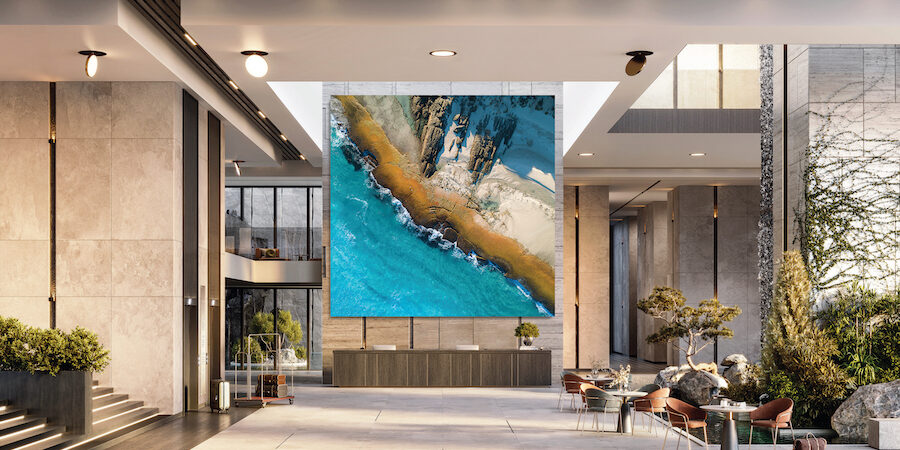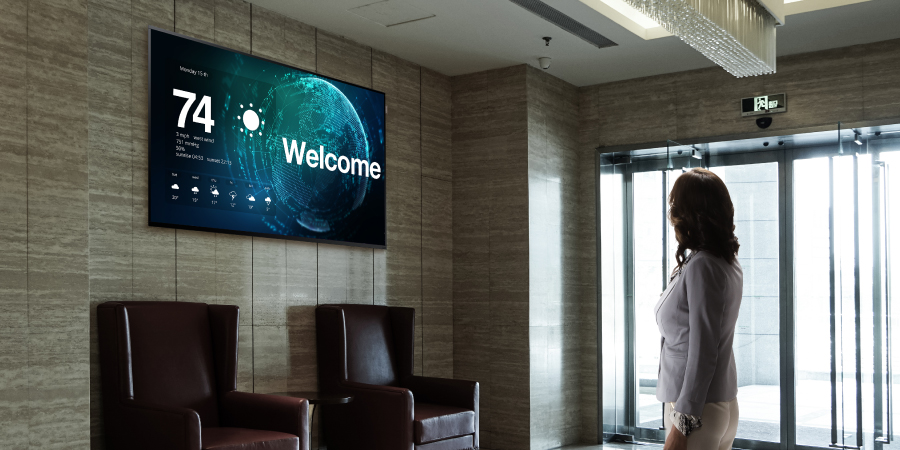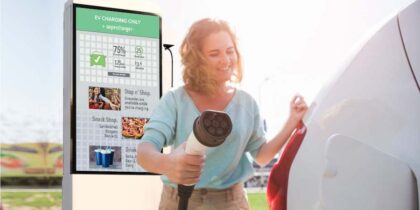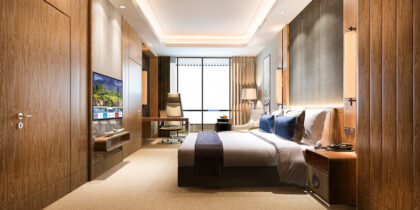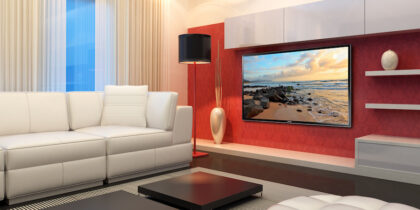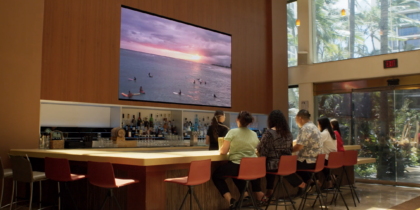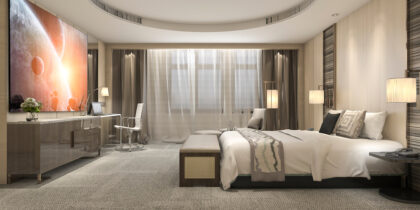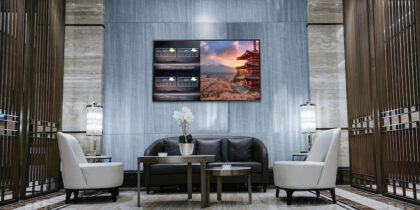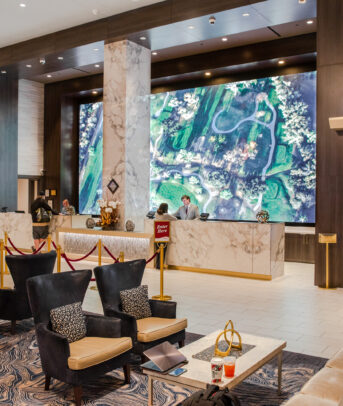The future of hotel signage is digital, as screens positioned around facilities elevate guest experiences, help operators streamline services and boost bottom lines for business.
Anyone who travels knows their hotel experience starts before they even walk through the door, as hotels can advertise using direct view LED displays on roadside totems or on the building’s facade. Dedicated smartphone apps, tied to loyalty programs and beacons, can begin messaging guests before they even walk in, speeding up check-ins and personalizing welcomes.
This experience extends from the reception desk to hotel services and amenities, and even guest rooms. Hotel operators are increasingly using screens to help guests navigate the facilities, raising awareness of high-margin services and taking the strain off front desk and concierge staff during busy check-in and check-out periods.
Hotel signage sets the tone for hospitality-focused establishments. That can mean anything from a three-display-wide welcome screen behind a reception desk to iconic video walls that are central to a hotel’s decor and ambiance.
Here’s a look at what hotels are already doing with display technology, and how that will expand and evolve for the hotel of the future.
Lobbies: Greeting the guest
As guests arrive, single displays or clusters of tiled screens behind reception counters convey welcome messages, universal or customized. If a big chunk of that week’s bookings involve a business convention or sports tournament, participants can be recognized at check-in. To fully ensure they are leaving a lasting impression the moment guests walk in, hotels can incorporate The Wall from Samsung. With its sleek, deep black background and customizable design, this LED video wall is ideal for lobbies. Hotels can draw in guests immediately with The Wall’s immersive visual aspects, as well as use its innovative features to rotate weekly or daily content based on guests’ needs. And now, The Wall All-in-One — with its built-in components and simplified installation — makes the dazzling splendor of a video wall attainable for even small boutique hotels.
Digital transformation and the guest experience
Learn how a single, unified digital solution can elevate and personalize your guest experience. Download Now
Another one of the most impactful digital signage applications in hospitality may be interactive information stations, sometimes called digital concierges. An interactive display in a lobby can itemize local dining, entertainment and attractions options, provide area maps, running routes, traffic conditions, and lists of area services, like nearby pharmacies, salons and specialized services. This technology can provide 24-hour resources for hotel guests during their stay, and even just one screen can relieve much of the pressure on busy reception staff to answer guest inquiries, notably at hotels not large enough to employ a full-time concierge staff.
Samsung Kiosk takes this functionality one step further by enabling guests to check themselves in or out, cut their own room keys and pay their bill. While this may seem like the opposite of hospitality, many customers prefer to use self-service technology. Kiosks can elevate operations, too: They help relieve bottlenecks at the front desk during peak check-in and check-out times and free up staff to engage in more meaningful interactions that boost brand affinity and foster long-term loyalty.
Facilities: Wayfinding, meetings, menus and EV charging
Large-footprint hotels with meeting and banquet facilities can be hard to navigate. Wayfinding and directory signs — interactive or not — are very useful in directing guests to business meetings, luncheons and special events in the banquet and meeting hall areas. If guests use the hotel app, beacons can provide them with step-by-step directions and push notifications during their stay.
Increasingly, digital signage software platforms are linking with hotel room management systems to automatically display meeting room information, saying, for example, that a company’s sales meeting is in Salon A. At the meeting room entrances, small screens — like the Samsung 13-inch interactive display — display information about who has booked each room. Replacing paper in slots, these signs can show the logo of a company or organization, detailed information or even the photo of a newly married couple for a wedding reception. When the room booking changes, so does the sign. Hotel room management can also place digital signage near or in elevators to point people toward restrooms and other necessities. This integration provides a whole new level of customization to the modern hotel experience and eases issues with content management.
Food services managers are using digital menu boards and other types of screens to replace printed material, enabling them to change menus and promotions by time of day and adjust promotions based on what’s selling and what needs more publicity. Even fine dining restaurants are using tools like tablets to replace cumbersome wine menus with digital versions that offer more details and tasting notes, and that tie into inventory systems — so if a wine isn’t in stock, it doesn’t show.
Meanwhile, meeting and event planners are taking advantage of digital hotel signage to retheme event halls instantly, changing out the visuals on large video feature walls, and making available tools like collaborative digital whiteboards in private meeting room spaces.
As electric vehicles (EVs) become more common, hotels can also attract guests with EV charging stations. These stations don’t just conduct power, they serve as mini-billboards that display constantly changing content such as traffic conditions, charging information, advertisements, menus, community messaging and more. Charging stations are a key benefit and a major consideration for guests who are traveling long distances by EV since most EVs can only drive 100 to 400 miles on a single charge.
With applications like these, digital signage is proving its effectiveness as a standard tool not just for the guest experience, but overall hotel operations.
Guest rooms: The key to communication
Digital is also finding its way, increasingly, into hotel rooms. Dedicated hotel apps can make an ultra-wideband (UWB)-enabled smartphone work as a secure room key. Once inside, Smart TVs tied to hotel management systems can already be turned on, with an on-screen message personally greeting a guest and driving promotions like room service, hotel amenities and late check-outs.
In high-end suites, LED video displays like The Wall and The Wall All-in-One provide guests with the ultimate viewing experience, whether it’s to watch a late-night movie or wake up to the morning news — all in the comfort of their private room.
Looking ahead
With more and more devices — even light bulbs and mattresses — getting Internet of Things (IoT) sensors, the hotel of the future will be increasingly smart. The guest experience will grow more visual and interactive, and screens will also start finding their way behind the scenes, as displays can also be used for training new staff, and making them aware of when rooms are clear and when services are requested.
Overall, eye-catching and dynamic screens will make hotel guests feel great about being there, but the technology also enables hotels to work better.
Impress your guests from the moment they enter your hotel with Samsung’s latest hospitality technology solutions. And continue enhancing the guest experience, build your brand and drive revenue with this free, complete guide.
